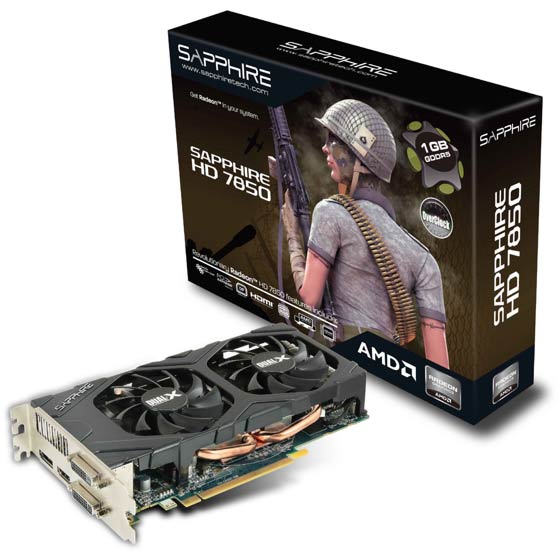SAPPHIRE is introducing three new updated graphics cards based upon the 28nm AMD HD 7850 GPU. The HD 7850 series are aimed at the mid range value performance area of the market and these updated cards from SAPPHIRE aim to bring a little more colour to the crowded middle ground through cooling improvements, lots of display output options and updated HDMI specifications.
SAPPHIRE’s new range of HD 7850 cards
|
HD 7850 Standard 1GB |
HD 7850 Standard 2GB |
HD 7850 OC Edition |
|
1GB DDR5 RAM |
2GB DDR5 RAM |
2GB DDR5 RAM |
|
Core clock of 900MHz |
Core clock of 860MHz |
Core clock of 920MHz |
|
Memory Clock 1200MHz |
Memory Clock 1200MHz |
Memory Clock 1250MHz |
|
Bandwidth 4.8Bb/s |
Bandwidth 4.8Bb/s |
Bandwidth 5Bb/s |
|
Dual BIOS |
Dual BIOS |
Dual BIOS |
|
Dual link DVI-I, Dual link DVI-D, HDMI 1.4a and Display Port |
Dual link DVI-I, Dual link DVI-D, HDMI 1.4a and Display Port |
Dual link DVI-I, Dual link DVI-D, HDMI 1.4a and Display Port |
|
Dual-X multi-heatpipe cooler with dual fans |
Dual-X multi-heatpipe cooler with dual fans |
Dual-X multi-heatpipe cooler with dual fans |
Dual-X Cooling
All three of the newly updated HD 7850 cards feature Dual-X. This is SAPPHIRE’s latest dual-extractor cooler, it is said to offer “highly efficient multi-heatpipe cooler with dual fans providing quiet and very cool operation during normal operating conditions, and superb cooling performance even under extreme load”.
At HEXUS we have seen the Dual-X before on the Sapphire Radeon HD 7970 OC Dual-X 3GB back in March and also on the HD 7950 OC cards. In our tests the SAPPHIRE cooler was “better than the reference in every way” offering superior cooling and very quiet performance. It’s a worthy inclusion in these mid-market graphics cards.
Monitor connections
These new HD 7850s also share a plethora of monitor output options. SAPPHIRE say that “Working or gaming with multiple monitors is becoming increasingly popular, and the SAPPHIRE HD 7800 series supports this with AMD Eyefinity, now in its second generation. In multi-monitor setups, SAPPHIRE HD 7800 series cards can simultaneously output multiple, independent audio streams allowing the correct audio content to be associated with different applications on different screens.” The cards also support fast HDMI 1.4a which enables Stereoscopic 3D with enhanced frame rates of 60Hz per eye. If you are lucky enough to get hold of a 4K display then these cards are ready for that too, using either 3GHz HDMI 1.4a or DisplayPort 1.2 HBR2.

Additional features
A new version of the TriXX overclocking tool is available for these graphics cards. The tool lets users tune the GPU voltage, core and memory clocks. TriXX also displays the graphic card temperature which can be moderated by fan speed profile presents. Overall quite a useful utility if you like to push your graphics card a bit. SAPPHIRE also highlights “APP Acceleration” of the HD7000 series of GPUs which enables the GPU to be utilised for demanding floating point tasks such as media transcoding and compression.
Pricing for these cards should be in the range from £160 to £200 depending upon your choice of clock speed/memory. As we’ve said before these HD7850 cards are worthy upgrades to graphic cards from a couple of generations behind and they are well rounded solutions in the sub £200 pricing segment for good 1080p performance. SAPPHIRE’s latest tweaks to the feature set reinforce the HD 7850’s flexibility and therefore attractiveness.






